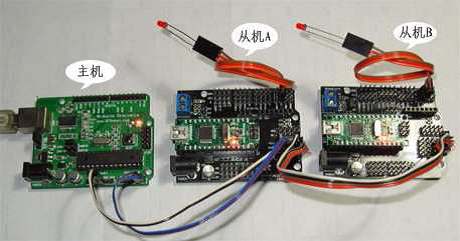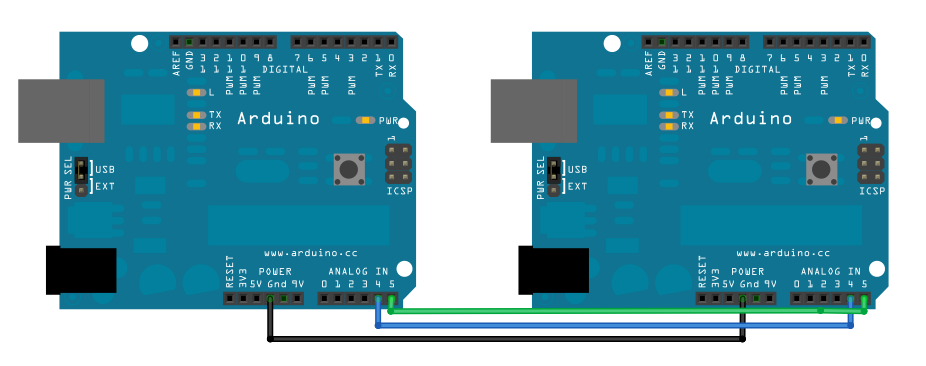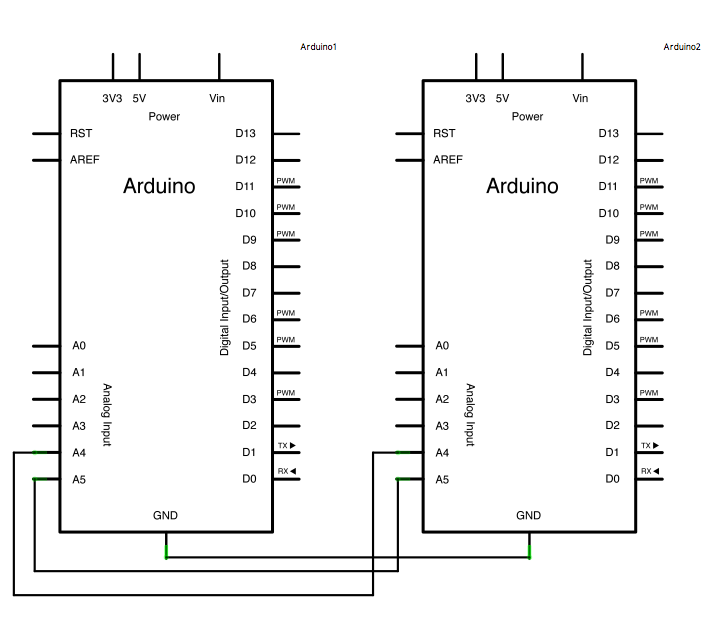I2C的库函数应用示例
I2C Arduino 简单应用举例
例1 多机通信

主机代码:(从编译器串口监视器发送数字1,2,3,4来控制从机的LED亮与灭)
1 #include <Wire.h>
2 void setup()
3 {
4 Wire.begin(); //启动I2C 总线,地址缺省表示为主机
5 Serial.begin(9600); //启动串口,设置波特率为9600
6 Serial.println("Ready"); //发送字符
7 }
8
9 void loop()
10 {
11 int val;
12 if(Serial.available() > 0) //判断串口缓冲器是否有数据装入
13 {
14 val=Serial.read(); //读串口
15 if(val==49) //1
16 {
17 Wire.beginTransmission(4); // 与地址4 的从机连接通讯
18 Wire.write(1); // 发送数字 1 开LED
19 Wire.endTransmission(); // 停止发送
20 Serial.println("49 OK"); // 串口上显示 49 OK 表示完成,49 表示为数字 1 的ASCII 码
21 delay(10);
22 }
23 else if(val==50)//2
24 {
25 Wire.beginTransmission(4); // 与地址4 的从机连接通讯
26 Wire. write (0); // 发送数字 0 关LED
27 Wire.endTransmission(); // 停止发送
28 Serial.println("50 OK"); // 串口上显示 50 OK 表示完成
29 delay(10);
30 }
31 else if(val==51) //3
32 {
33 Wire.beginTransmission(5); // 与地址5 的从机连接通讯
34 Wire. write (1); // 发送数字 1 开LED
35 Wire.endTransmission(); // 停止发送
36 Serial.println("51 OK"); // 串口上显示 51 OK 表示完成
37 delay(10);
38 }
39 else if(val==52) //4
40 {
41 Wire.beginTransmission(5); // 与地址5 的从机连接通讯
42 Wire.write (0); // 发送数字 0 关LED
43 Wire.endTransmission(); // 停止发送
44 Serial.println("52 OK"); // 串口上显示 52 OK 表示完成
45 delay(10);
46 }
47 else
48 { Serial.println(val); }
49 }
50 }
从机A代码:(接收到主机发送的1点亮LED,接收到0关掉LED)
1 #include <Wire.h>
2 int LED = 2;
3
4 void setup()
5 {
6 Wire.begin(4); // 设置从机地址为 4
7 pinMode(LED,OUTPUT); // 设置IO 口为输出模式
8 Wire.onReceive(receiveEvent); //从机接收主机发来的数据
9 }
10
11 void loop()
12 { delay(100); }
13
14 void receiveEvent(int howMany) // 接收从主机发过来的数据
15 {
16 int c = Wire.receive(); // 接收单个字节
17 if(c==1)
18 { digitalWrite(LED,HIGH); // 如果为 1 开LED }
19 else if(c==0)
20 { digitalWrite(LED,LOW); // 如果为 0 关LED }
21 }
从机B代码:(接收到主机发送的1点亮LED,接收到0关掉LED)
1 #include <Wire.h>
2 int LED = 2;
3
4 void setup()
5 {
6 Wire.begin(5); // 设置从机地址为 5
7 pinMode(LED,OUTPUT);
8 Wire.onReceive(receiveEvent);
9 }
10
11 void loop()
12 { delay(100);}
13
14 void receiveEvent(int howMany)
15 {
16 int c = Wire.receive();
17 if(c==1)
18 { digitalWrite(LED,HIGH); }
19 else if(c==0)
20 { digitalWrite(LED,LOW); }
21 }
例2 Master Reader/Slave Sender 从发主收信息共享
In some situations, it can be helpful to set up two (or more!) Arduino and Genuino boards to share information with each other(彼此共享信息). In this example, two boards are programmed to communicate with one another in a Master Reader/Slave Sender configuration(配置) via the I2C synchronous serial protocol(I2C同步串行协议).Several functions of Arduino's Wire Library are used to accomplish this. Arduino 1, the Master, is programmed to request, and then read, 6 bytes of data sent from the uniquely addressed Slave Arduino. Once that message is received, it can then be viewed in the Arduino Software (IDE) serial monitor window.
The I2C protocol involves using two lines to send and receive data: a serial clock pin (SCL) that the Arduino or Genuino Master board pulses at a regular interval, and a serial data pin (SDA) over which data is sent between the two devices. As the clock line changes from low to high (known as the rising edge of the clock pulse), a single bit of information - that will form in sequence the address of a specific device and a command or data - is transferred from the board to the I2Cdevice over the SDA line. When this information is sent - bit after bit -, the called upon device executes the request and transmits it's data back - if required - to the board over the same line using the clock signal still generated by the Master on SCL as timing.
Because the I2C protocol allows for each enabled device to have it's own unique address, and as both master and slave devices to take turns communicating over a single line, it is possible for your Arduino or Genuino board to communicate (in turn) with many devices, or other boards, while using just two pins of your microcontroller.
Hardware Required
- 2 Arduino or Genuino Boards
- hook-up wires
Circuit
Connect pin 4 (the data, or SDA, pin) and pin 5 (the clock, or SCL, pin) on the master board to their counterparts on the slave board. Make sure that both boards share a common ground. In order to enable serial communication, the master board must be connected to your computer via USB.
If powering the boards independently is an issue, connect the 5V output of the Master to the VIN pin on the slave.

Schematic

Code for Master Reader - Program for Arduino 1
1 #include <Wire.h>
2
3 void setup()
4 {
5 Wire.begin(); // join i2c bus (address optional for master)
6 Serial.begin(9600); // start serial for output
7 }
8
9 void loop()
10 {
11 Wire.requestFrom(8, 6); // request 6 bytes from slave device #8
12 while (Wire.available())
13 {
14 char c = Wire.read(); // receive a byte as character
15 Serial.print(c); // print the character
16 }
17 delay(500);
18 }
Code for Slave Sender - Program for Arduino 2
1 #include <Wire.h>
2
3 void setup()
4 {
5 Wire.begin(8); // join i2c bus with address #8
6 Wire.onRequest(requestEvent); // register event
7 }
8
9 void loop()
10 { delay(100); }
11
12 void requestEvent()
13 {
14 Wire.write("hello "); // respond with message of 6 bytes as expected by master
15 }
例3 Master Writer/Slave Receiver 主发从收信息共享
Hardware Required,Circuit,Schematic 同例2
Master Writer Code - Program for Arduino 1
1 #include <Wire.h>
2 byte x = 0;
3
4 void setup()
5 { Wire.begin(); // join i2c bus (address optional for master) }
6
7 void loop()
8 {
9 Wire.beginTransmission(8); // transmit to device #8
10 Wire.write("x is "); // sends five bytes
11 Wire.write(x); // sends one byte
12 Wire.endTransmission(); // stop transmitting
13 x++;
14 delay(500);
15 }
Slave Receiver Code - Program for Arduino 2
1 #include <Wire.h>
2
3 void setup()
4 {
5 Wire.begin(8); // join i2c bus with address #8
6 Wire.onReceive(receiveEvent); // register event
7 Serial.begin(9600); // start serial for output
8 }
9
10 void loop()
11 { delay(100);}
12
13 void receiveEvent(int howMany)
14 {
15 while (1 < Wire.available())
16 {
17 char c = Wire.read(); // receive byte as a character
18 Serial.print(c); // print the character
19 }
20 int x = Wire.read(); // receive byte as an integer
21 Serial.println(x); // print the integer
22 }
I2C的库函数应用示例的更多相关文章
- linux下创建库函数
来源: 在Linux下如何使用自己的库函数-riverok-ChinaUnix博客 http://blog.chinaunix.net/uid-21393885-id-88128.html 构建Lin ...
- STM32模拟I2C
之前为了测试, 拿最小板做了一个I2C的主发跟主读, 一开始当然是尝试用硬件I2C, 结果弄了很久, 时间紧迫, 只好用了模拟, 结果发现, 哎, 真特么挺好用的, 现在1片儿顶过去5片儿. 硬件I2 ...
- NHibernate查询示例合集
基本查询 复杂查询示例 /// <summary> /// 获取自定义表单数据中属于部门的部分 /// </summary> /// <param name=&quo ...
- Python---socket库
为方便以后查询和学习,特从常用库函数和示例来总结socket库 1. 术语 family:AF_INET socktype:SOCK_STREAM或SOCK_DGRAM protocol:IPPROT ...
- 程序设计与算法(一)C语言程序设计CAP之字符串
C++中的字符串 字符串有三种形式 用双引号括起来的字符串常量,如果"CHINA"."C++ program" 存放于字符串数组中,以'\0'字符(ASCII吗 ...
- 剑指offer——把字符串转换成整数(c++)
题目描述请你写一个函数StrToInt,实现把字符串转换成整数这个功能.当然,不能使用atoi或者其他类似的库函数. 示例 1:输入: " -42"输出: -42解释: 第一个非空 ...
- Programiz 中文系列教程·翻译完成
原文:Programiz 协议:CC BY-NC-SA 4.0 欢迎任何人参与和完善:一个人可以走的很快,但是一群人却可以走的更远. 在线阅读 ApacheCN 学习资源 目录 Programiz C ...
- Programiz C 语言教程·翻译完成
原文:Programiz 协议:CC BY-NC-SA 4.0 欢迎任何人参与和完善:一个人可以走的很快,但是一群人却可以走的更远. 在线阅读 ApacheCN 学习资源 目录 C 简介 C 关键字和 ...
- GNU Readline库函数的应用示例
说明 GNU Readline是一个跨平台开源程序库,提供交互式的文本编辑功能.应用程序借助该库函数,允许用户编辑键入的命令行,并提供自动补全和命令历史等功能.Bash(Bourne Again Sh ...
随机推荐
- Sorting It All Out (拓扑排序+思维)
An ascending sorted sequence of distinct values is one in which some form of a less-than operator is ...
- Oracle (实例名/服务名)SID和Service_Name的区别
可以简单的这样理解:一个公司比喻成一台服务器,数据库是这个公司中的一个部门.1.SID:一个数据库可以有多个实例(如RAC),SID是用来标识这个数据库内部每个实例的名字,就好像一个部门里,每个人都有 ...
- 推荐一个IT老鸟肝了2月有余的免费开源WPF企业级开发框架
一个新学WPF的IT老鸟,肝了2个月做了这么一个WPF企业级开发框架,站长clone学习,觉得甚是不错.这是一个使用了Prism搭建的插件式框架,封装了DataGrid的使用,使整个框架子模块简单易学 ...
- C++类重载函数的function和bind使用
在没有C++11的std::function和std::bind之前,我们使用函数指针的方式是五花八门,结构很繁琐难懂.C++11中提供了std::function和std::bind统一了可调用对象 ...
- ZT:做一个连自己都羡慕的人
当你越来越杰出时,自然有人关注你, 当你越来越有能力时,自然会有人看得起你, 改变自己,你才有自信,梦想才会慢慢的实现. 做最好的自己,懒可以毁掉一个人,勤可以激发一个人! 不要等夕阳西下的时候才对自 ...
- Netty内置的编解码器和ChannelHandler
Netty 为许多通用协议提供了编解码器和处理器,几乎可以开箱即用,这减少了你在那些相当繁琐的事务上本来会花费的时间与精力. 通过SSL/TLS 保护Netty 应用程序 SSL和TLS这样的安全协议 ...
- flag在index里
题目:http://123.206.87.240:8005/post/ 我们来看这一题 首先打开题目 他让点击就点击呗 跳转到另一个新的界面 这就没了??? ... 没思路就对了 //假装证明自 ...
- Mybatis----Mapper配置文件
<?xml version="1.0" encoding="UTF-8" ?> <!DOCTYPE mapper PUBLIC "- ...
- JDK1.7之前的Bug之静态代码块
程序的主入口是main方法,但是在jdk1.7之前,可以没有main方法也一样能运行,很是不可思议,到底是什么原因呢?,大家都知道在类中定义了静态代码块的话,是首先执行代码块里的语句的,如果把静态代码 ...
- MVC中将枚举类型数据应用到下拉列表中的方法
例如: public enum ItemTypes { Movie = 1, Game = 2, Book = 3 } 在MVC2.0中如何将以上枚举类型使 ...
